Standard [CURRENT]
ASTM F 3690:2024
Standard Test Method for Evaluating Suture Anchor Insertion and Pull Displacement Resistance
- Publication date
- 2024
- Original language
- English
- Pages
- 13
- Publication date
- 2024
- Original language
- English
- Pages
- 13
- DOI
- https://dx.doi.org/10.1520/F3690-24
Product information on this site:
Quick delivery via download or delivery service
Buy securely with a credit card or pay upon receipt of invoice
All transactions are encrypted
Short description
1.1 This test method provides mechanical performance considerations and standard test methods for measuring basic properties of suture anchors that are implanted into bone. The suture anchors that may be evaluated by this test standard can have varying designs such as "all-suture" anchors (in which the device is made completely of monofilament or multifilament braided wire, tape, or any kind of flexible yarn), or multi-component anchors, such as those which have an anchor body intended for implantation in the bone and separate suture component (for example, threaded anchor, impact anchor, expandable anchors). 1.2 This standard does not address testing methods for absorbable or degradable devices (including anchors and/or sutures). This standard does not address testing methods for device removal or evaluation of device removal risks. The insertion verification testing presented in this standard does not address end user validation testing or usability testing/human factors testing which may need to replicate the operating environment (for example, visualization, knot tying under exposure to biological fluids). Multiple test methods are included in this standard for basic characterization. However, the test types in this standard may not address all end user/customer needs that are important for development of your suture anchor (for example, abrasion testing to evaluate the performance of the anchor/suture interface, characterization of insertion torque or force relative to human factors). The user is not necessarily obligated to use only the tests identified in this standard, nor are they obligated to test their device using all of the described methods. Instead, the user should only select, with justification, test methods that are appropriate for a particular device design. This may only be a subset of the test methods described herein. This test method does not address the evaluation of other soft tissue fixation devices including but not limited to interference screws or cortical buttons. 1.3 The values stated in SI units are to be regarded as standard. No other units of measurement are included in this standard. 1.4 Optional acceptance criteria are also presented within this standard for fatigue testing of anchors that is consistent with protected post-operative loading simulations of successful devices present in the literature. Optional acceptance criteria are also presented for anchor insertion testing which identify reasonable bone foam substrates to represent healthy bone. However, the user is not obligated to test their device to the acceptance criteria presented in the annexes. Users of this test method may instead use other well-supported justifications to demonstrate why the device's insertion and tensile verification testing performance is acceptable for clinical use. 1.5 This standard does not purport to address all of the safety concerns, if any, associated with its use. It is the responsibility of the user of this standard to establish appropriate safety, health, and environmental practices and determine the applicability of regulatory limitations prior to use. 1.6 This international standard was developed in accordance with internationally recognized principles on standardization established in the Decision on Principles for the Development of International Standards, Guides and Recommendations issued by the World Trade Organization Technical Barriers to Trade (TBT) Committee.
ICS
11.040.40
DOI
https://dx.doi.org/10.1520/F3690-24
Also available in
Loading recommended items...
Loading recommended items...
Loading recommended items...
Loading recommended items...

